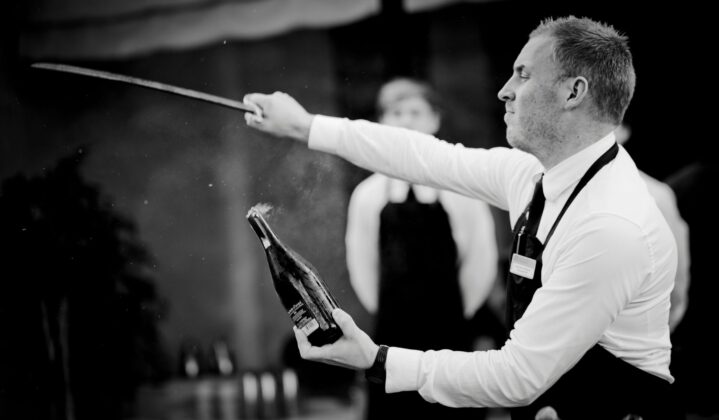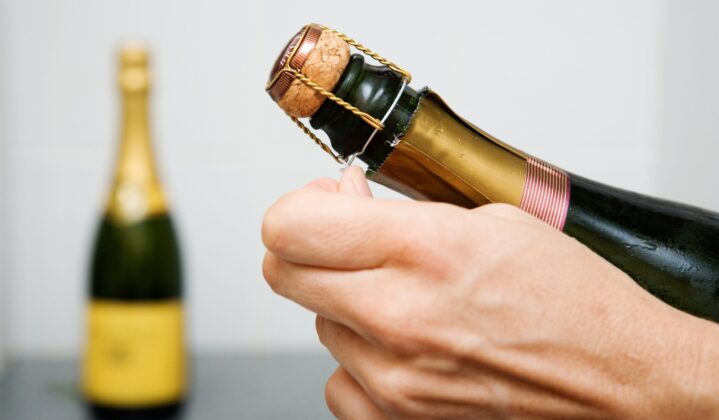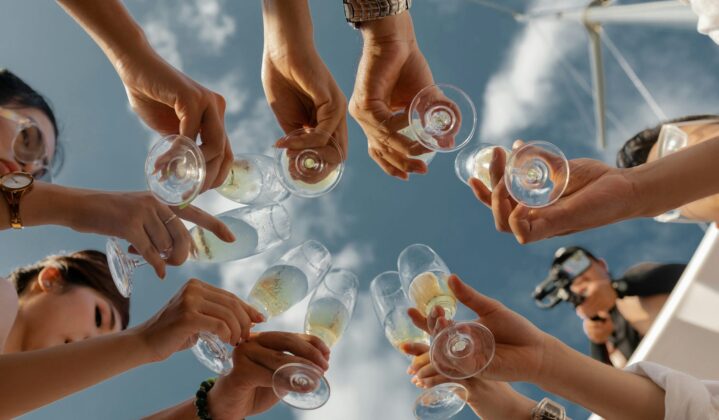Common Mistakes When Sabering Champagne and How to Avoid Them
Sabering champagne is a theatrical and joyous act, turning an ordinary bottle opening into a moment of awe and celebration. Yet, this art form requires precision, preparation, and a calm state of mind. Even the smallest missteps can lead to awkward situations—or worse, accidents.
Here are the most common mistakes people make when sabering champagne and how you can refine your technique to achieve that perfect, clean break every time.
1. Neglecting the Proper Bottle Choice
Not all champagne bottles are suitable for sabering, and this is one of the most underestimated mistakes. Some bottles are designed with thicker glass, particularly those containing sparkling wines or prosecco, which aren’t always structured to break cleanly under pressure. Screw tops are another common culprit—these bottles simply aren’t engineered for sabering and can result in dangerous glass shards flying unpredictably.
To avoid this mistake, always choose a standard champagne bottle with a cork and wire cage. Traditional bottles are crafted to handle high pressure and are built with seams that guide the saber for a controlled break. Additionally, inspect the bottle for any visible imperfections, such as micro-cracks or chips, which can weaken the glass and create unexpected outcomes.
2. Rushing Through the Process
Excitement can cloud judgment. Many people rush into sabering without taking a moment to prepare, resulting in poorly executed attempts. The urge to impress often overshadows the need for methodical precision, leading to mistakes like holding the saber at the wrong angle, skipping critical steps, or applying too much force.
Sabering champagne should be approached as a ritual, not a race. Take the time to prepare your bottle: chill it adequately, locate the seam, and rehearse your motion mentally. This not only sets the stage for a flawless saber but also allows you to enjoy the process with confidence and poise. Remember, the elegance of sabering lies in its deliberate execution.
3. Failing to Chill the Bottle Properly
Temperature plays a pivotal role in successful sabering, yet this step is often overlooked or improperly executed. When a champagne bottle is too warm, the internal pressure increases significantly, making the glass more resistant to a clean break. Conversely, over-chilling the bottle can cause the glass to become excessively brittle, increasing the risk of an uncontrolled shatter.
For optimal results, chill the bottle to around 45°F (7°C) for at least three hours before sabering. Focus on cooling the neck specifically, as this is the critical breaking point. If you’re short on time, placing the bottle in an ice bath for 30 minutes can be an effective alternative. This ensures a balanced internal pressure and the ideal glass temperature for a smooth, controlled saber.
4. Overlooking the Bottle Seam
The seam of the champagne bottle is more than just a subtle design feature—it’s the structural weak point where the glass is most likely to break cleanly. Failing to identify and align your saber along this seam is a frequent misstep that can lead to uneven breaks or complete failure to detach the neck.
Take a moment to examine the bottle under good lighting, as the seam can sometimes be difficult to spot. Align the saber with the seam and run it along the line to familiarize yourself with its path before making your swing. This attention to detail is crucial for a successful sabering experience.
5. Using Improper Tools
While sabering videos on social media might make it look like any household item can suffice—knives, spoons, even shoes—using improper tools is a surefire way to risk disaster. Household items lack the weight and design necessary for effective sabering, leading to uneven pressure and dangerous glass breakage.
Invest in a high-quality champagne saber designed specifically for this purpose. The blade’s dull edge is crafted to apply the right amount of force without cutting into the glass, ensuring a clean break. The weight and balance of a proper saber also give you better control, allowing for a more seamless and safe experience.
6. Applying the Wrong Amount of Force
 Sabering isn’t about brute strength. Many people mistakenly believe they need to swing the saber with excessive force, which can shatter the bottle instead of creating a clean break. On the other hand, a timid, hesitant motion often fails to detach the neck, leaving you with a half-completed attempt.
Sabering isn’t about brute strength. Many people mistakenly believe they need to swing the saber with excessive force, which can shatter the bottle instead of creating a clean break. On the other hand, a timid, hesitant motion often fails to detach the neck, leaving you with a half-completed attempt.
The key lies in a firm, fluid motion. Think of it as a steady follow-through rather than a hard swing. The goal is to glide the saber along the seam with just enough force to release the pressure at the neck. Practicing this motion on an empty bottle (without sabering) can help you develop the confidence and muscle memory needed for success.
7. Ignoring Safety Precautions
The excitement of sabering can sometimes overshadow the importance of safety. Flying glass shards, unpredictable bottle pressure, and crowded spaces are all potential hazards if proper precautions aren’t taken. Neglecting these can turn a celebratory moment into an unfortunate accident.
Always saber champagne in an open, clear area with no one standing in the line of trajectory. Keep a safe distance between yourself and any bystanders—at least 10 feet is recommended. Consider wearing gloves and safety glasses, especially if you’re new to sabering. While these measures might seem unnecessary to some, they add an extra layer of protection for a worry-free experience.
8. Poor Grip and Bottle Angle
How you hold the champagne bottle can make or break (literally) your sabering attempt. A common mistake is gripping the bottle near the neck, which not only compromises control but also puts your hand at risk of injury. Holding the bottle at the wrong angle—either too upright or too flat—can also lead to uneven force distribution.
Grip the bottle firmly at its base with your non-dominant hand, keeping your fingers clear of the neck. Angle the bottle at 30-45 degrees, ensuring the cork is pointing away from people or fragile objects. This position allows the pressure inside the bottle to work in your favor, propelling the cork and neck cleanly away.
9. Improper Holding Technique of Saber
The way you hold the saber significantly impacts the outcome of your sabering attempt. An improper grip often leads to imprecise strokes, uneven pressure, and a higher risk of accidents. Sabering is about finesse and control, not brute force, and the right holding technique ensures the saber moves as an extension of your arm.
For optimal results, grip the saber at the center of the handle with a firm yet relaxed hold. Avoid gripping too tightly, as this can cause stiffness and limit the fluidity of your motion. Position your thumb along the side of the handle to provide balance and guidance. Gripping too far back reduces leverage, while holding too close to the blade disrupts control and increases the chance of injury.
A proper grip enhances precision and confidence, allowing the saber to glide seamlessly along the bottle’s seam. Practice with an empty bottle to build familiarity with the motion, ensuring both safety and a successful sabering experience when it’s time to celebrate.
10. Forgetting to Loosen the Wire Cage Before Sabering

The wire cage securing the cork is often treated as an afterthought, but skipping this step can create unnecessary obstacles. Attempting to saber with the cage fully tightened can prevent the neck from detaching cleanly, resulting in a failed attempt or shattered glass.
Loosen the cage beforehand, leaving it in place to maintain structural integrity while allowing the saber to break through smoothly. This small but critical step ensures a clean break without compromising the bottle’s safety.
11. Lack of Practice
Finally, the most avoidable mistake is diving into sabering without any preparation or practice. While the technique might seem straightforward, it requires a combination of precision, confidence, and muscle memory that only come with practice.
Consider starting with inexpensive sparkling wines to familiarize yourself with the process before moving on to higher-quality champagne. Practicing on an empty bottle can also help you refine your grip, angle, and swing. The more comfortable you become with the motions, the more effortless and impressive your sabering will appear.
A Celebration Worth Mastering

Sabering champagne is more than just an impressive party trick—it’s a celebration of skill, tradition, and the shared joy of the moment. By avoiding these common mistakes, you can elevate your sabering experience into a flawless and memorable performance. With the right preparation, tools, and mindset, you’ll not only master the art of sabering but also create a spectacle that’s as thrilling to perform as it is to witness.
